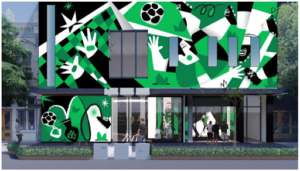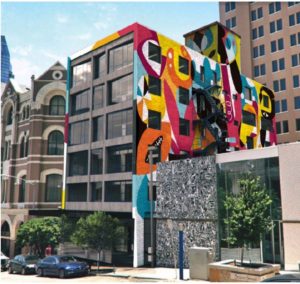Landmark commission denies Congress building owner’s request for mural
Tuesday, December 22, 2020 by
Sean Saldaña Last month, the Historic Landmark Commission discussed a proposal to install an eye-catching, soccer-themed mural at 506 Congress Ave.
The mural, which would have been completed by the artist Ruben Sánchez, was noteworthy because it would be located near the Robinson-Rosner Building and the Scarbrough Building in the Congress Avenue Historic District.

The proposed mural for 506 Congress Ave.
At the time, the commission expressed concerns about the mural’s vibrance.
Historic Preservation Officer Steve Sadowsky called the proposal “a little disrespectful of the context of the Congress Avenue Historic District.”
But by the end of the meeting, the commission decided to table any voting due to a lack of procedural clarity in city guidelines. According to commission documents, “Austin does not have specific guidelines for murals within historic districts.”
At the Dec. 14 meeting, commissioners finally came to a decision – to deny the request.
The deciding factor likely came down to the mural’s placement on the building’s facade. Despite the fact that 506 Congress Ave. isn’t a historic building or contributing to the historic district, staffers still recommended denying the mural because of its location “between two historic landmarks.”
Since the city has no formal specifications for murals in historic districts, the commission looked to other cities for guidance – in this case, Milwaukee.
During the meeting, Sadowsky said, “We don’t have, in the city of Austin, any guidelines for murals … the draft guidelines that we found for the city of Milwaukee, Wisconsin, seemed very well thought out.”
Milwaukee’s mural guidelines lay out a detailed list of application requirements, design standards and removal requirements for murals located in historic districts.
Austin city staffers focused on three specifications in particular. First, they felt it important that building owners establish a maintenance agreement to ensure that murals don’t become dilapidated with time. The other two specifications have to do with the mural’s location and size.
According to Sadowsky, Milwaukee adopted requirements that a mural “should not be on the principal facade of the building. (It) should be on the side and should not exceed 50 percent of the wall on which it is placed.”
A mural placed on the facade of a building would face out toward the street, making it more visible to the general public. It was this increased visibility that raised red flags for city staff.
Sadowsky elaborated, saying, “Last month when we brought this up, one of our principal concerns was that it is right on Congress Avenue. It’s not only that it is between historic landmarks, it is not consistent with the historic character of the Congress Avenue Historic District.”
The commissioners voted unanimously against the proposal, but the meeting also provided an additional case study in the commission’s thought process.
The commission actually approved a similar proposal – a mural painted by Ruben Sánchez – at 610 Brazos St. The primary difference in that proposal was that the mural would be painted on the side of the building, not the front.

The approved mural at 610 Brazos St.
Going forward, the landmark commission plans to hammer out more specific guidelines pertaining to murals in historic districts.
During the comment period, Commissioner Ben Heimsath said, “I do think that we should instruct the staff to – post-haste – see if we can create some guidelines to make it more obvious to store owners in the future what we will and won’t approve.”
Renderings courtesy of the city of Austin.
The Austin Monitor’s work is made possible by donations from the community. Though our reporting covers donors from time to time, we are careful to keep business and editorial efforts separate while maintaining transparency. A complete list of donors is available here, and our code of ethics is explained here.
You're a community leader
And we’re honored you look to us for serious, in-depth news. You know a strong community needs local and dedicated watchdog reporting. We’re here for you and that won’t change. Now will you take the powerful next step and support our nonprofit news organization?










